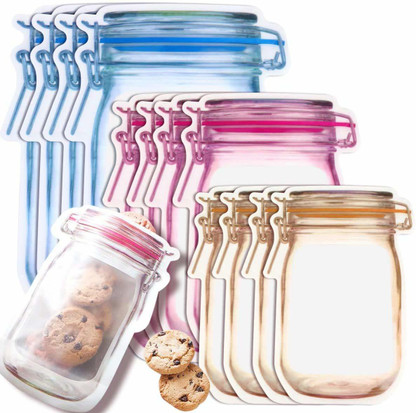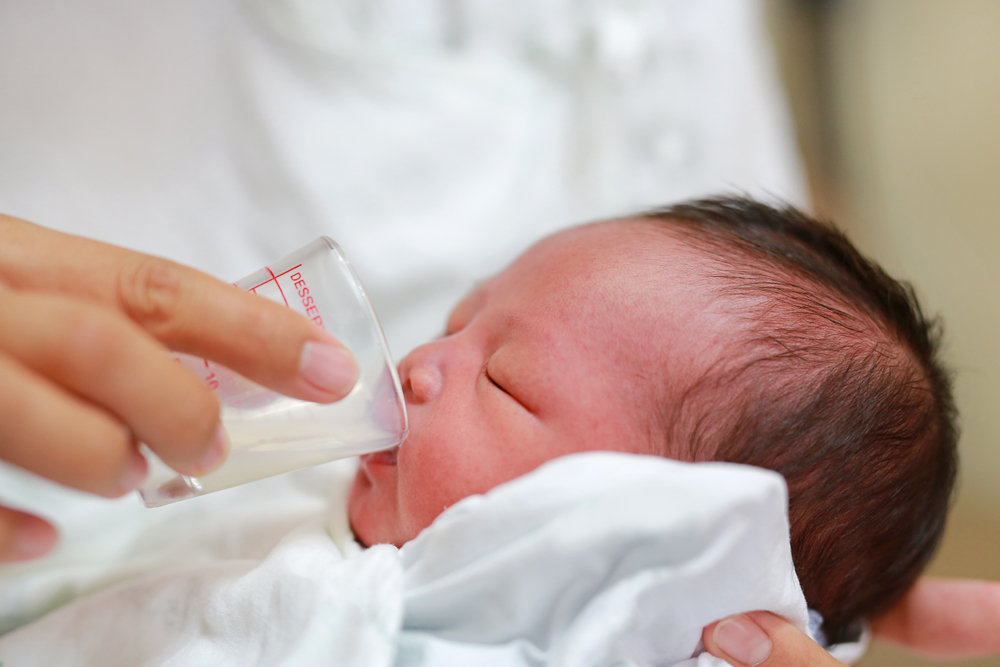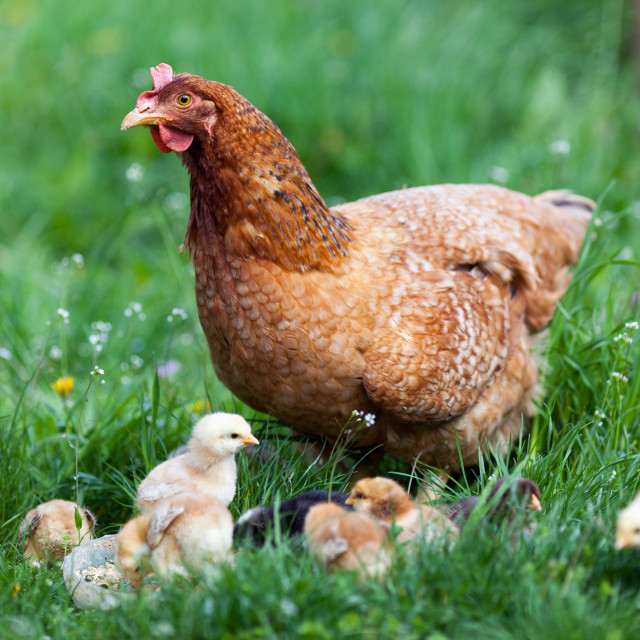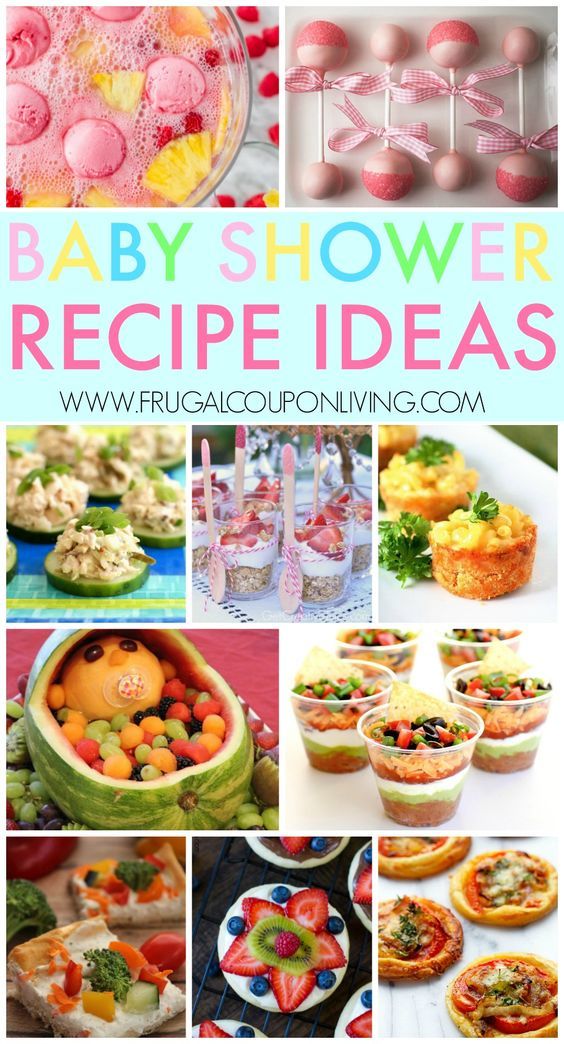1 yr old baby food schedule
Easy Feeding Schedule for 1 Year Olds
11, 12, and 13 months plus can be a difficult time to determine a feeding schedule with so many transitions from baby food and bottles. Get these sample feeding schedules for 1 year olds from a feeding expert and mom.
This post is sponsored by Litecup USA.
A baby’s first year is filled with many changes, and as it comes to a close around 11 to 12 months, often one of the biggest changes is fully transitioning to table foods and totally leaving behind baby food. At the same time, parents are also trying to navigate how to wean from breast or bottle. Many parents feel overwhelmed and are unsure how to make these changes, and understandably so.
Although I cover transitioning to table food and bottle weaning here in lots of detail, it is important to have a feeding schedule in mind too because it helps make these big transitions successful. Today, I’m sharing three sample schedules with you that I use as a licensed occupational therapist for babies 11, 12, and 13 months old. Basically, a feeding schedule for 1 year olds, so you can see how to make the transitions work for you.
It is fitting that the sponsor of this post is Litecup USA, a no-spill open cup that also lights up! I know, I’m blowing your mind. Think how perfect that will be when you’re in the car in the evening or to have on the nightstand for a quick sip if they need it in the middle of the night! It is genius! And, it’s fun! Kids, including mine, love it. You will find more in the post about when and why an open cup is great for toddlers.
Feeding at 11, 12, and 13 Months (Aka The 1 Year Old!)
If I had to pick one word to summarize feeding babies at this age, it would be: unpredictable. Honestly, they are so busy and easily distracted that at some meals hardly anything is eaten and others they may seem to eat more than you. This is normal, and I want you to keep that mind. It is important to not jump through too many hoops to get your child to eat, because they will soon learn how to wield that power. Setting up a routine and schedule around meals goes a long way in curbing the unpredictability and potential picky eating.
Setting up a routine and schedule around meals goes a long way in curbing the unpredictability and potential picky eating.
I would also encourage you to move completely to table foods by 11 months, if you haven’t done so already. An occasional pouch is okay when you are out and about, but by this age babies should be eating a variety of table foods. The schedules I share below are made based on this assumption. See further down in the post if your child is having difficulty with this transition.,
In my 8-10 month old feeding schedule, I recommended introducing a straw. If you haven’t done that yet, no problem, they will likely pick it up very quickly. While the straw is a great choice, at this age, your child may be ready to drink from an open cup. I know how shocking that sounds. It is a surprise to most parents, but stay with me.
Open cup drinking is an important developmental skill, and challenges children to use the muscles in and around their mouth in new and different ways.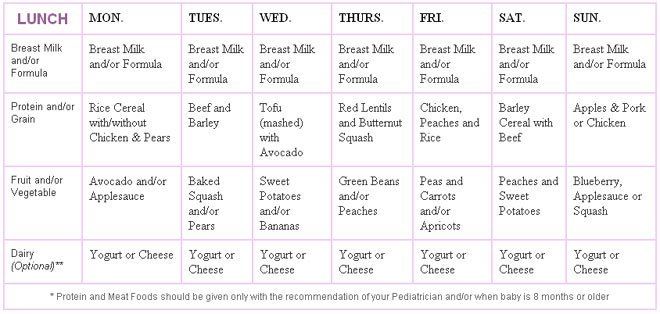 This helps them progress with managing different types of food, as well as their speech. Great, right? But, what about the mess? It is true that there will be a lot of spills and wet shirts with traditional open cups, or you can use a Litecup that has all the benefits of drinking from an open cup without any of the mess! Win- win! I love it, it is the best of both worlds. So be brave and give the open cup a chance. It is a wonderful tool to add into your routine, as you can serve your child’s milk and water in it during mealtime.
This helps them progress with managing different types of food, as well as their speech. Great, right? But, what about the mess? It is true that there will be a lot of spills and wet shirts with traditional open cups, or you can use a Litecup that has all the benefits of drinking from an open cup without any of the mess! Win- win! I love it, it is the best of both worlds. So be brave and give the open cup a chance. It is a wonderful tool to add into your routine, as you can serve your child’s milk and water in it during mealtime.
Because this is a time of transition, I’m going to share with you three schedules so that you can see the transitions. First, you will see the schedule at the beginning of 11 months, then you will see it once the baby is weaned, usually around the first birthday or in the next few months. In the latter case, I gave you samples for either one or two naps, as this is often a transition at this age too! Of course, all of these factors vary from child to child.
Get more specifics for bottle weaning and breast weaning.
*Learn 5 Big Mistakes that Parents (Unknowingly) Make When Feeding Their Baby or Toddler Table Foods in my free workshop. And, learn what to do to help them eat well!*
*This schedule is just a sample. Your child may sleep at different times and you will need to adjust accordingly. I suggest taking note of the time intervals so that you can apply to you child’s individual schedule. You can use this 1 year old sleep schedule as a reference.
6:30-7:00 AM: Wake-Up – Breastfeed/Bottle upon waking *This is usually the second to last feeding you will take away. Sometimes it’s the last if your child is more attached to this than the night time feed.
7:00-7:30 AM: Breakfast – Water available in an open cup or straw cup, table foods (include a fruit/veggie, carbohydrate, and protein).
9:30 AM: Nap
11:00 AM: Breastfeed/Bottle upon waking *This is usually the first milk feeding I take away, if there are no complaints from the baby, and I promptly feed them lunch instead with milk in a cup. Some babies may start to nurse or take very little from a bottle earlier than their birthday. It is okay to follow their lead.
Some babies may start to nurse or take very little from a bottle earlier than their birthday. It is okay to follow their lead.
11:30-12:00 PM: Lunch – Water in a straw cup, table foods (include a fruit/veggie, carbohydrate, and protein).* Give milk at this meal once the previous formula/breast milk is eliminated.)
1:30-2:00 PM: Nap
3:30 PM: Breastfeed/Bottle upon waking, immediately followed by an optional small snack such as fruit and crackers/dry cereal/rice cake. *This is typically the second bottle or breast feeding I take away, but it can be the first if this works better. Once this bottle is gone, offer milk in a cup and some protein to the meal like peanut butter, hummus, cheese, or beans.
6:00 PM: Dinner – Water in an open cup or straw cup, table foods (include a fruit/veggie, carbohydrate, and protein).
7:30- PM: Breastfeed/Bottle before bed *Typically this is the last breastfeed or bottle you will take away, and it can be the most difficult.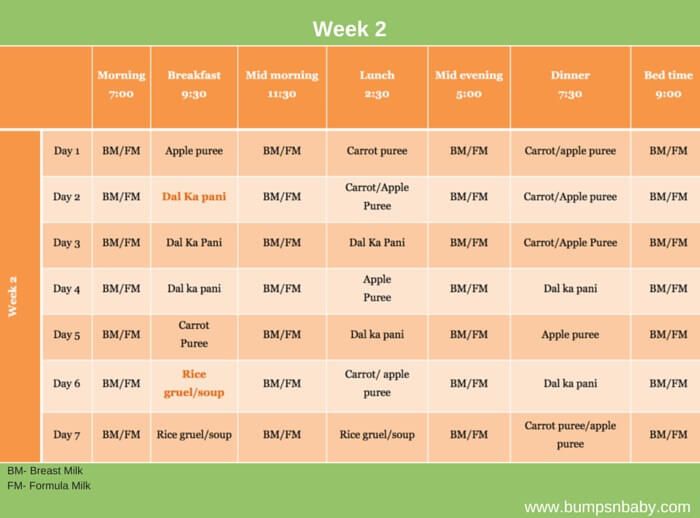 However, feedings at this time won’t interfere with their other meals.
However, feedings at this time won’t interfere with their other meals.
7:45-8:00 PM: Sleeping for the night
*Times are given in a range of possible start times, not duration. If you are concerned about how much your baby needs to eat, see this post on Portion Sizes.
Specifically, this is an example around 12 – 13 months
7:30 – 8:00 AM: Breakfast – 15-30 minutes after waking. About 4 oz. of milk in an open cup or straw, a protein, carbohydrate, and fruit/veggie.
10:30 AM: Nap
12:00 PM: Lunch – 15-30 minutes after waking. About 4 oz. of milk in an open cup or straw, a protein, carbohydrate, and fruit/veggie.
2:30 PM: Snack – About 4 oz. of milk in an open cup or straw, a protein, carbohydrate, and fruit/veggie.
3:00 PM: Nap
5:30 – 6:00 PM: Dinner – About 4 oz. of milk in an open cup or straw, a protein, carbohydrate, and fruit/veggie.
Beginning around 12-13 months Old
7:30- 8:00 AM: Breakfast – 15-30 minutes after waking. About 4 oz. of milk in an open cup or straw, a protein, carbohydrate, and fruit/veggie.
About 4 oz. of milk in an open cup or straw, a protein, carbohydrate, and fruit/veggie.
11:00 AM: Lunch – About 4 oz. of milk in an open cup or straw, a protein, carbohydrate, and fruit/veggie.
12:00 PM: Nap
2:30- 3:00 PM: Snack – 15-30 minutes after waking: About 4 oz. of milk in an open cup or straw, a protein, carbohydrate, and fruit/veggie. *This meal should include all the elements listed, but will be on a little smaller of a scale.
5:30 – 6:00 PM: Dinner – About 4 oz. of milk in an open cup or straw, a protein, carbohydrate, and fruit/veggie.
A Few Feeding Tips
- Milk should be around 16 oz. total for the day after 1 year of age.
- Ideally, meals should be spaced 2.5 – 3 hours apart, counting from the start of one meal to the start of the next.
- Babies and toddlers are capable of feeding themselves a lot of food at this age. Yes, it’s messy, read the benefits here. I encourage you to allow them to feed themselves as much as possible, even with a spoon!
- If your baby is gagging a lot or you’re nervous about their occasional gag, then head to What You Need to Know About Baby Gagging.

- Try to have as much variety in your toddler’s diet as possible, ideally not serving the same thing two days in a row. Need some inspiration? I’ve got you covered! See The Mega List of Table Foods or The Ultimate List of Meals for Toddlers.
- If you’re concerned about how many calories they’re eating or need to increase your babies weight, then see High Calorie Foods for Babies.
- Around this time you may also be considering getting rid of the binky or dummy, if so, I’ve got a guide that will help you know when and how to do it. Check out Everything You Need to Know About Pacifier Weaning.
What If This Eating Thing Isn’t Going Well?
If you feel like your baby isn’t getting the hang of table foods or is consistently eating very small amounts of food at 10 months of age, then I would strongly suggest scheduling an evaluation through early intervention (if you live in the states) or seeking out a private or outpatient therapist. I also have this free printable: Learn to Eat Table Foods Cheat Sheet, that I’ll send right to your inbox. It has a step-by-step plan and some other tips that will be helpful.
I also have this free printable: Learn to Eat Table Foods Cheat Sheet, that I’ll send right to your inbox. It has a step-by-step plan and some other tips that will be helpful.
Get the Free Printable Here!
Unfortunately, many times, pediatricians advise to wait it out, but trained feeding therapists (usually OTs and SLPs) are able to catch early signs of underlying sensory or motor difficulties. The earlier these problems are addressed, the easier they are to overcome. Head to Everything About Feeding Therapy to read more.
More on Feeding Schedules for Babies from Your Kid’s Table
The Best 6 and 7 Month Old Feeding Schedule, So Easy to Follow
Introducing Baby Food: Everything You Need to Know
The Ultimate Guide to Feeding Milestones for Babies and Toddlers
Feeding Red Flags for Babies and Toddlers
Did You Pin This?
You’ll want to check this out again! Pin it here or hover/tap on any image to get the pin it button.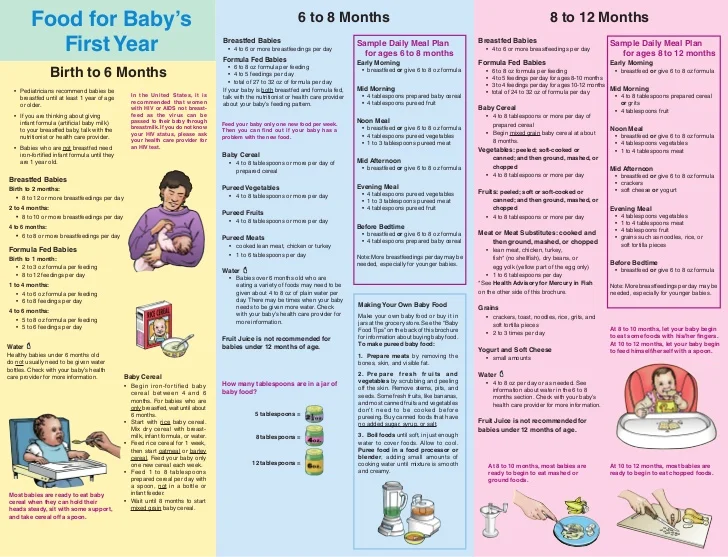
Alisha Grogan is a licensed occupational therapist and founder of Your Kid’s Table. She has over 14 years experience with expertise in sensory processing and feeding development in babies, toddlers, and children. Alisha also has 3 boys of her own at home. Learn more about her here.
1 Year Old Feeding Schedule (With Sample Meal Plans)
Here’s a look at sample one year old feeding schedules to help you manage (or create!) your routine. I have options for one year olds taking bottles, being breastfed, or being on all solids—plus sample menu plans!
One Year Old Feeding Schedule
Once a baby turns one and is eating meals and snacks, it can help to establish a routine to make it all easier on you to manage. Feeding kids is a lot of work and a basic feeding schedule is a great place to start.
This is meant to offer guidance and to be adjusted for your reality, whatever that may look like, since I know that no two families have the same schedules or eating preferences.
Sample 1 Year Old Feeding Chart
I’m going to share three versions of a sample feeding charts to give you an idea of the time intervals between meals based on when the kiddo wakes up and goes to bed. Generally speaking, 2-3 hours between solid food is a good rule of thumb—though always remember that your child may be hungrier some days than others and may need that timeframe adjusted.
Version 1
This example is for a toddler who’s taking milk in a sippy cup with meals (or drinks water with meals). Let’s assume wake up time is a little after 6 and bedtime is 7 pm. There may or may not be a morning nap, but there is an assumed afternoon nap from about 1-3 pm.
- 6:30 am: Breakfast
- 9 am: Snack
- 12 pm: Lunch
- 3 pm: Snack
- 5:30 pm Dinner
TIP: There could be a simple Bedtime Snack in the mix if needed before bed.
Version 2
This example is for a toddler who’s still drinking bottles and has water with meals. Let’s assume wake up time is 7 and bedtime is 8 pm. There may or may not be a morning nap, but there is an assumed afternoon nap from about 1-3 pm.
Let’s assume wake up time is 7 and bedtime is 8 pm. There may or may not be a morning nap, but there is an assumed afternoon nap from about 1-3 pm.
- 7 am: bottle
- 8 am: Breakfast
- 10 am: Snack
- 12 pm: Lunch
- 1 pm: bottle
- 4 pm: Snack
- 6 pm Dinner
- 7:30 pm: bottle
TIP: We want to wean kids from bottles by 2 at the latest, and the sooner you do it, the easier it often is. Work on transitioning the milk consumption to be with meals during the one year old year, rather than separate standalone bottles, especially if it seems to be limiting hunger for solids.
Version 3
This example is for a toddler who’s breastfed and has water with meals. Let’s assume wake up time is 6:30 am and bedtime is 7:30 pm. There may or may not be a morning nap, but there is an assumed afternoon nap from about 1-3 pm. There of course may be more nursing sessions in the mix here if the child is nursed on demand, so adjust as needed for your real life.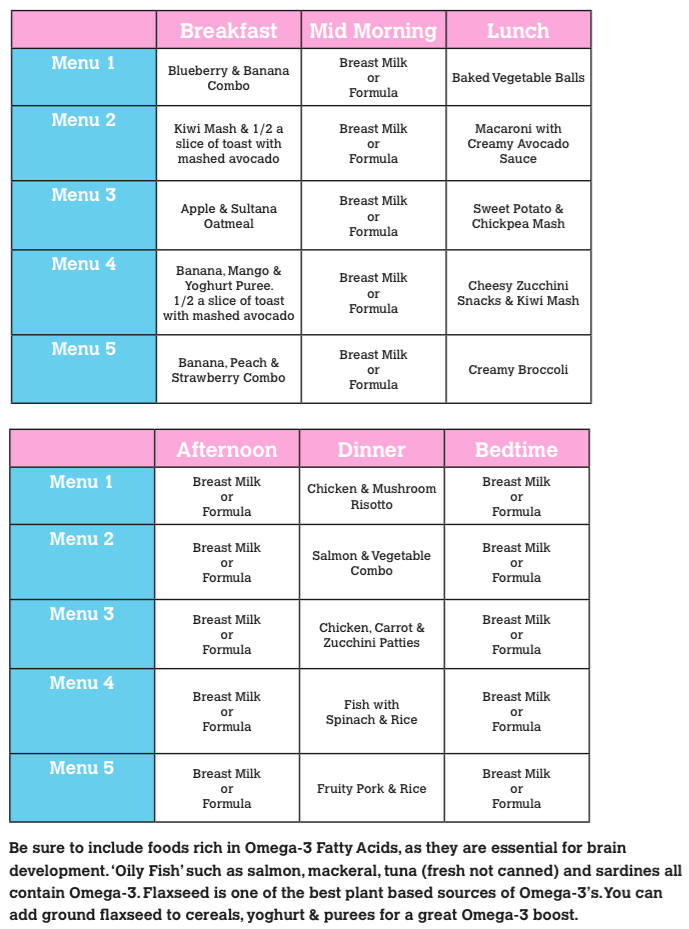
- 6:30 am: breastfeeding
- 7:30 am: Breakfast
- 9:30 am: Snack
- 12 pm: Lunch
- 1 pm: breastfeeding
- 4 pm: Snack
- 6 pm: Dinner
- 7 pm: breastfeeding
TIP: If the child doesn’t seem hungry for snacks, you don’t always have to do them. They may be full from the breastmilk and solids. If breast feeding seems to be limiting hunger for solids, you can consider tapering down the daytime sessions if you want. (No pressure, just know that some kids aren’t hungry enough for all meals and snacks and breastmilk during their one year old year so something could be adjusted if desired.
1 Year Old Meal Plan
I prefer to have a general framework for when meals happen because it helps me to plan the rest of the day. It also helps the kids to generally know what to expect and when, even if it’s as simple as learning that we go outside after morning snack and do our bedtime routine after dinner.
TIP: Find a week’s worth of Sample Meals for Toddlers here.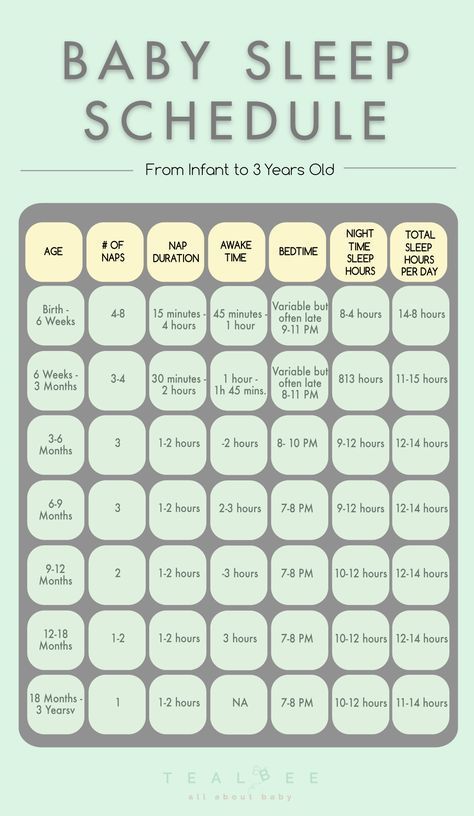
Frequently Asked Questions
How often do you feed a 1 year old?
Toddlers generally eat around every 2-3 hours, but that may vary depending on their own unique hunger.
How many bottles should a 1 year old have per day?
After turning 1 year, a child may be having a few bottles, but we want to transition over to sippy cups of milk served with meals by 18-24 months. If the child doesn’t seem hungry for solids, that could be a good reason to start tapering down separate milk feedings.
How many meals should a one year old have each day?
Most one year olds eat 3 main meals and 2 snacks. That may vary based on whether there are bottles or breastfeeding in the mix.
How many oz should a one year old eat?
The best guide for the amount of food any child should eat is their own unique hunger. Start with smaller portions and allow more according to their hunger. (Read more about the Division of Responsibility in Feeding for more of the reason behind approaching meals this way.)
Start with smaller portions and allow more according to their hunger. (Read more about the Division of Responsibility in Feeding for more of the reason behind approaching meals this way.)
Why doesn’t my one year old eat foods they loved as a baby?
There are may possible reasons, but there are two common ones. First, one year olds grow less rapidly than they did as babies and are often less hungry. This may mean they eat fewer and less foods than they used to. Second, there is a normal developmental phase known as neophobia where kids are more fearful of new and less familiar foods.
Both can happen at this age and can look like “pickiness” to parents. (It’s frustrating, I know, but my goal is to simply point out that there are often clear reasons behind the behavior we’re seeing.)
Picky Eating in One Year Olds
I hear from a lot of parents with 14-19 month olds who are suddenly “picky” and aren’t interested in the food that they used to love as a baby. Here’s what to keep in mind if that describes your situation:
Here’s what to keep in mind if that describes your situation:
It is very normal for one year olds to grow less rapidly than they did as babies, and to have a correspondingly lower appetite. It is very common for parents to see kids eating less and fewer foods and assume it’s “pickiness” when in fact the child is simply not as hungry as we expect them to be.
Try serving smaller portions, spacing out meals or snacks a bit, and letting it be okay if the child eats less than you expect.
Also developmentally, kids this age are exploring all of their boundaries—from the color of their socks to the fork they prefer to whether or not they want to walk on the sidewalk—so it’s normal to see some of this show up at the dinner table.
This is not a sign that anything is necessarily wrong, but is it usually a normal part of the kids realizing they are independent from us, have the power to say “no” (and get a reaction), and voice their opinions.
Remember: It’s not your job to “get” your child to eat. It’s your job to offer a variety of food that is tasty, easy for them to chew, and developmentally appropriate. It’s also our job to set the routine for when and where meals happen and what things are like during meals—we sit in our chairs, we don’t throw our food, etc. It’s their job to decide how much of the food to eat and which foods.
It’s your job to offer a variety of food that is tasty, easy for them to chew, and developmentally appropriate. It’s also our job to set the routine for when and where meals happen and what things are like during meals—we sit in our chairs, we don’t throw our food, etc. It’s their job to decide how much of the food to eat and which foods.
If we expect these factors during toddlerhood, it’s much easier to empathize and understand why they are happening—and realize that our kids are doing the normal work of figuring out their world.
TIP: Toddlers go through a normal phase called “neophobia” where they are naturally more skeptical of less familiar foods (or even foods they haven’t seen in a few days or weeks). Read up on that developmental stage so you can keep what you’re experiencing in perspective.
How do I know if my toddler is eating enough?
The general rule of thumb is to consider if the child is growing, gaining weight, and meeting milestones.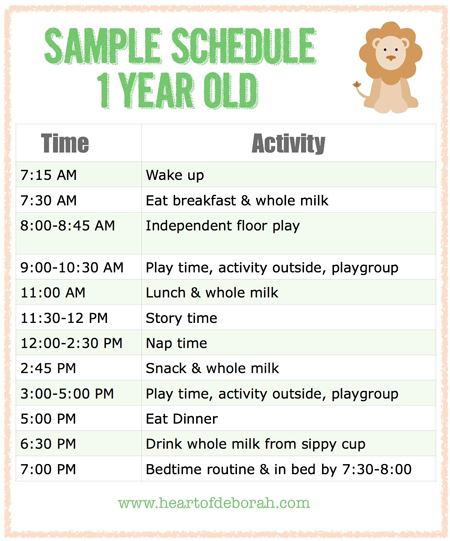 Do they mostly seem happy? If the answers to all of those are yes, chances are very high that the kiddo is eating plenty. But, if your gut tell you that something is off or your pediatrician is concerned with growth (such as falling off of the child’s own unique growth curve), you may need additional help from your pediatrician or a feeding therapist.
Do they mostly seem happy? If the answers to all of those are yes, chances are very high that the kiddo is eating plenty. But, if your gut tell you that something is off or your pediatrician is concerned with growth (such as falling off of the child’s own unique growth curve), you may need additional help from your pediatrician or a feeding therapist.
TIP: I recommend Thrive by Spectrum Pediatrics and Lutz, Alexander & Associates Nutrition Therapy for personalized feeding therapy. My ebook How to Relax about Picky Eating can help too.
Best Tips for Success
- Plan to have a general feeding schedule, that can adjust to realities of life, to make it easier on you to plan—and easier for the kids to know what to expect from their day.
- Allow 2-3 hours between solids, adjusting for the child’s hunger as needed.
- Aim to transition off of bottles by 18-24 months. (And learn why you don’t need Toddler Formula unless medically advised.)
- Here are more Sample Toddler Meal Plans to refer to as the kids grow and a basic Toddler Nutrition Chart.
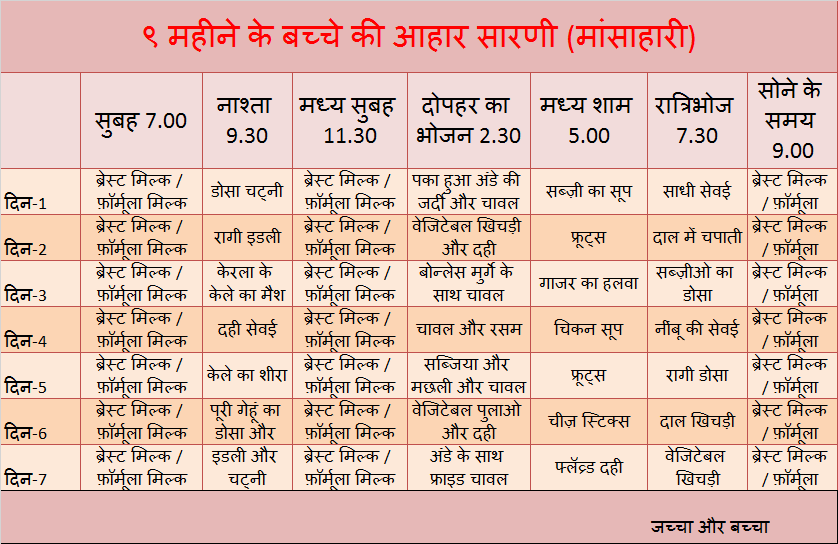
- Learn more about how to Wean a Toddler and how to Night Wean.
- If you’re worried about picky eating, this post on what’s normal will help.
- For help on understanding how to trust the kids to eat to their own unique fullness, start with the Division of Responsibility and then see this post with FAQ on Picky Eating.
I’d love to hear your feedback on this post, so please comment below to share!
Union of Pediatricians of Russia
Nutrition for children from 1 to 3 years of age
The period from 1 to 3 years of life is a crucial stage in the transition to an adult type of nutrition, which has certain features. In order to ensure that all the necessary nutrients enter the child's body and at the same time prevent an excess of individual nutrients, nutrition should be balanced and varied. nine0003
The daily amount of food for children aged 1 to 1.5 years should be 1000-1200 g, from 1.5 to 3 years - 1200-1500 g, the amount of food in one feeding should not exceed 300-350 ml. The diet consists of three main meals per day and two snacks. It is considered optimal when breakfast is 25% of the total energy density of the diet, lunch is 30–35%, dinner is 20%, and additional meals are about 10%. In general, the child can eat the same food as the rest of the family. nine0003
The diet consists of three main meals per day and two snacks. It is considered optimal when breakfast is 25% of the total energy density of the diet, lunch is 30–35%, dinner is 20%, and additional meals are about 10%. In general, the child can eat the same food as the rest of the family. nine0003
In the diet of a child of 1–3 years of age , must be present daily: meat of animals or poultry, dairy and sour-milk products, vegetables, fruits, bread, cereals, vegetable and butter; fish and eggs are included in the diet 2-3 times a week.
Cereal products: bread - 2-3 servings per day, cereals and side dishes - 1 time per day
Fruit and/or vegetables: at least 5 times a day
Dairy products: at least 3 servings per day (including those used to make cereals, yoghurts, fermented milk drinks, cottage cheese, infant formula or breast milk). nine0003
Domestic pediatricians recommend, when compiling a diet for children aged 1–3 years, preference should be given to specialized children's dairy products of industrial production that meet high quality requirements and safety indicators for this age. Most children's dairy products are additionally enriched with vitamins and/or minerals and other biologically active components, taking into account the physiological needs of children of this age. At the same time, in foreign recommendations, children over 1 year old are offered the gradual introduction of whole cow's milk, which is rich in fats necessary for proper growth and development, the absorption of vitamins A and D, the development of the child's brain and nervous system. nine0003
Most children's dairy products are additionally enriched with vitamins and/or minerals and other biologically active components, taking into account the physiological needs of children of this age. At the same time, in foreign recommendations, children over 1 year old are offered the gradual introduction of whole cow's milk, which is rich in fats necessary for proper growth and development, the absorption of vitamins A and D, the development of the child's brain and nervous system. nine0003
Meat dishes: 2-3 times a day
Fish dishes: 2-3 servings per week
Eggs: 2-3 per week
Dietary fats: 3-4 teaspoons of butter and/or vegetable oils per day
When cooking, use the minimum amount of salt and sugar, and do not add them to industrial products.
Offer your child a variety of foods and let them choose for themselves. Children love to eat on their own, so if possible, offer food that the child can eat with their hands. nine0003
It is important to remember that a baby can choke on pieces of food, so whatever you give your baby should be crushed or cut into small pieces that can be easily chewed.
Do not give to a small child: nuts, whole grapes, cherry tomatoes (unless quartered), whole carrots, seeds (such as pumpkin or sunflower seeds), round candies, legumes, raisins, because a child can eat them choke.
Also in the diet of children of the first 3 years of life should not be present:
Mushrooms; canned snacks, pickled vegetables and fruits
Home canned food
Dry concentrates for side dishes
Hot sauces, mustard, horseradish, pepper, vinegar, mayonnaise
Natural coffee
Juices and drinks in the form of dry concentrates; sweet carbonated drinks
Products containing food additives (flavorings, dyes of artificial origin, including chewing gum), popcorn
Combined fats; cakes and pastries
It is important to remember that children of this age should not be given too spicy and spicy foods.
Menu for a 1 year old child for a week, rules and recipes
Menu author: Natalia Dik — pediatrician. She graduated from the Chelyabinsk Medical Academy, clinical internship and residency, specialty pediatrics. She has been working in her specialty since 2007, from 2005-2008 she has been the head of the Allergy Department of the City Clinical Hospital No. 1 of Chelyabinsk, since 2008 she has been a specialist in clinical trials of drugs. She enjoys cooking and practices the Menu of the Week system in her daily life. nine0067 She graduated from the Chelyabinsk Medical Academy, clinical internship and residency, specialty pediatrics. She has been working in her specialty since 2007, from 2005-2008 she has been the head of the Allergy Department of the City Clinical Hospital No. 1 of Chelyabinsk, since 2008 she has been a specialist in clinical trials of drugs. She enjoys cooking and practices the Menu of the Week system in her daily life. nine0067 |
What food should be on a child's menu after the first birthday? Perhaps there is no mother who would not ask herself this question at least once.
The baby more and more confidently eats not only pureed dishes, but also dishes with small pieces of food, his diet at 1 year old gradually expands, the menu becomes more diverse and as a result, the mother has a lot of opportunities for culinary experiments.
It is possible and necessary to experiment, because it is at an early age that a child develops eating habits . You don't want him to turn his nose away from a plate of food in the future because it contains fried onions or baked broccoli, do you? Then start introducing him to a variety of products and how to cook them now!
You don't want him to turn his nose away from a plate of food in the future because it contains fried onions or baked broccoli, do you? Then start introducing him to a variety of products and how to cook them now!
Things to remember when compiling a menu for a child after 1 year:
- First of all, try to follow the same feeding schedule for better production of digestive enzymes . It is recommended to give "adult" food to babies 5 times a day at intervals of 3.5-4 hours: breakfast, lunch, afternoon snack, dinner and milk or kefir at night. It is very good if the mother's lactation is preserved, and it is possible to continue natural feeding on demand. Usually, children ask for a breast in the morning after waking up, in the afternoon after taking regular meals, or in between and before bedtime. With artificial feeding, babies usually continue to drink formula milk in the morning and before bedtime after a year. nine0086
- Diversifying the diet of is easy: just include vegetables, fruits, cereals, protein products (milk and dairy products, legumes, meat, fish) and fats (vegetable, butter, sour cream) in it every day.
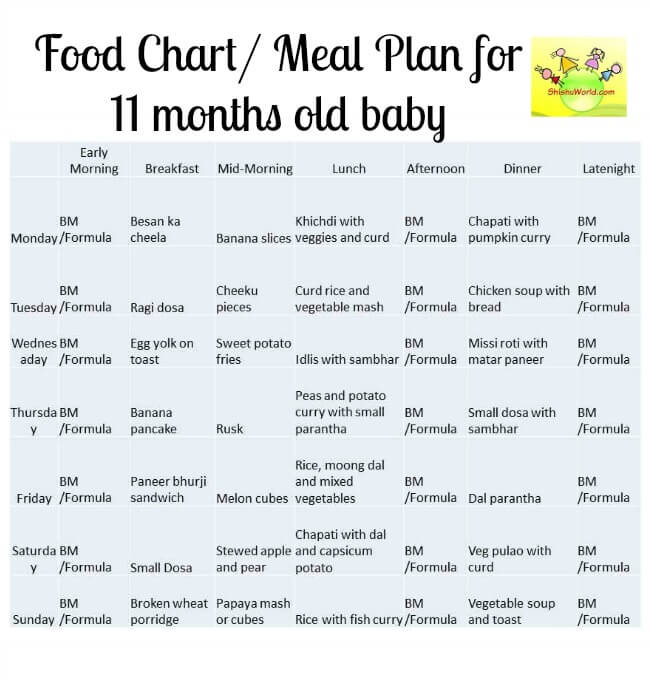 For example, if there was a cereal side dish for lunch, it is better to cook a vegetable dish for dinner, and vice versa.
For example, if there was a cereal side dish for lunch, it is better to cook a vegetable dish for dinner, and vice versa. - The most optimal ways of cooking are stewing, boiling (in water or steam), baking. But there are some peculiarities: if you cook soup in broth, it is better to use boneless meat and drain the first broth to avoid overstimulation of digestive enzymes
- You can gradually introduce children to various spices and seasonings (cinnamon, coriander, cumin, etc.). Of course, a lot of spicy additives (pepper, garlic) are best avoided, as well as products with artificial flavors (seasonings containing monosodium glutamate, etc.). It will be more useful if the baby learns to enjoy natural tastes.
- All mothers are well aware that water is very important for the health and well-being of babies, so make sure that your child drinks enough water between feedings (in extreme cases, unsweetened tea or a decoction of herbs, rose hips).
 You can pour water every morning into a sippy cup or bottle in a volume of about 300 ml and periodically offer him a drink. nine0086
You can pour water every morning into a sippy cup or bottle in a volume of about 300 ml and periodically offer him a drink. nine0086
MONDAY
Breakfast: Wheat porridge
Lunch: Pumpkin puree soup recipe with chicken
Dinner: Zucchini and carrot casserole
Pediatrician's comment:At lunch , broth and steamed vegetables are often offered. In my opinion, puree soups combine two dishes at the same time, thereby saving time on cooking. Complementing them with steam cutlets or meatballs (from meat, poultry or fish), we get a full meal. nine0067
|
TUESDAY
Breakfast: Oatmeal Porridge with Caramel Apples
Lunch: Broccoli Soup, Fish Meatballs
Dinner: Zucchini and Carrot Casserole
Pediatrician's comment: For afternoon snack you can give your baby fruit (if there are still problems with pieces, then in the form of puree or grated), cottage cheese, yogurt or kefir with children's cookies. |
Wednesday
breakfast: Puding from cottage cheese
Lunch: Broccoli soup
Dinner: buckwheat porridge
9000 9000
Pediatrician's comment:
Many children even a year prefer to have breakfast with breast milk or formula (if they are formula-fed). Dairy porridge has always been considered a tasty and satisfying breakfast. In addition, you can cook cottage cheese casserole or scrambled eggs. nine0067
Thursday
Breakfast: Omlet
Lunch: Puree soup
Dinner: Buckwheat porridge
Pediatrician's comment: For dinner many children have enough porridge or vegetable puree. |

 nine0067
nine0067 



